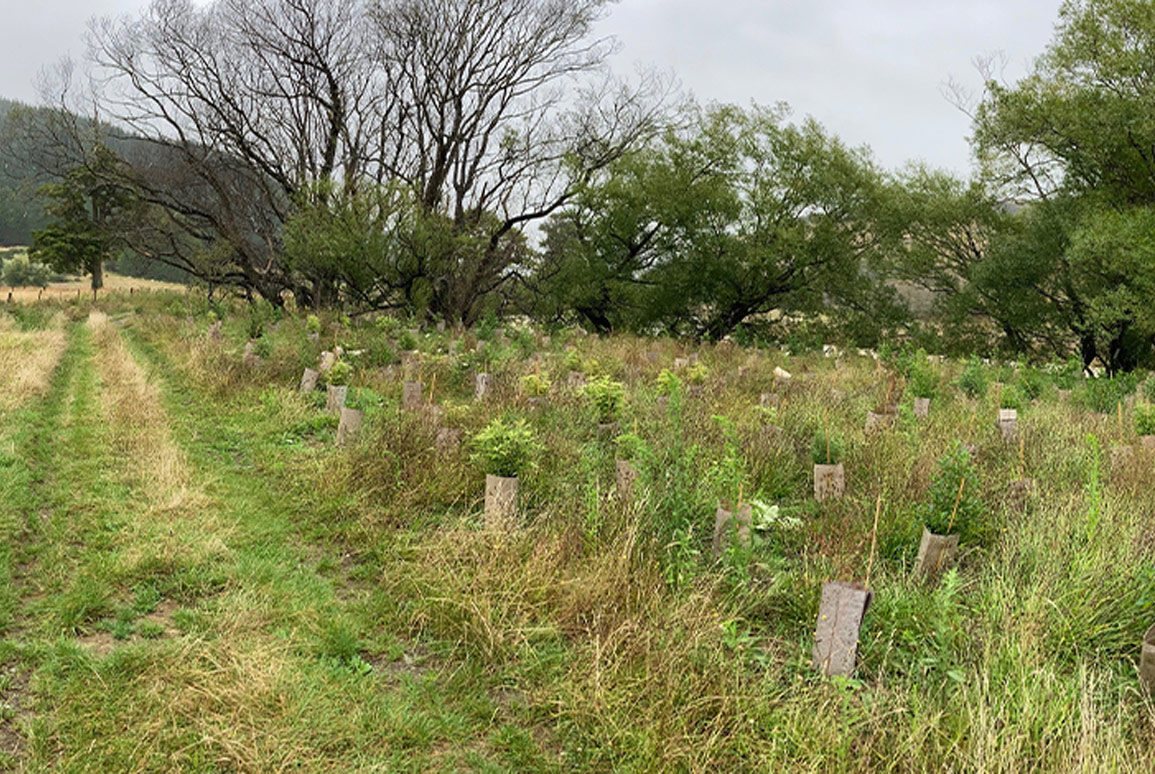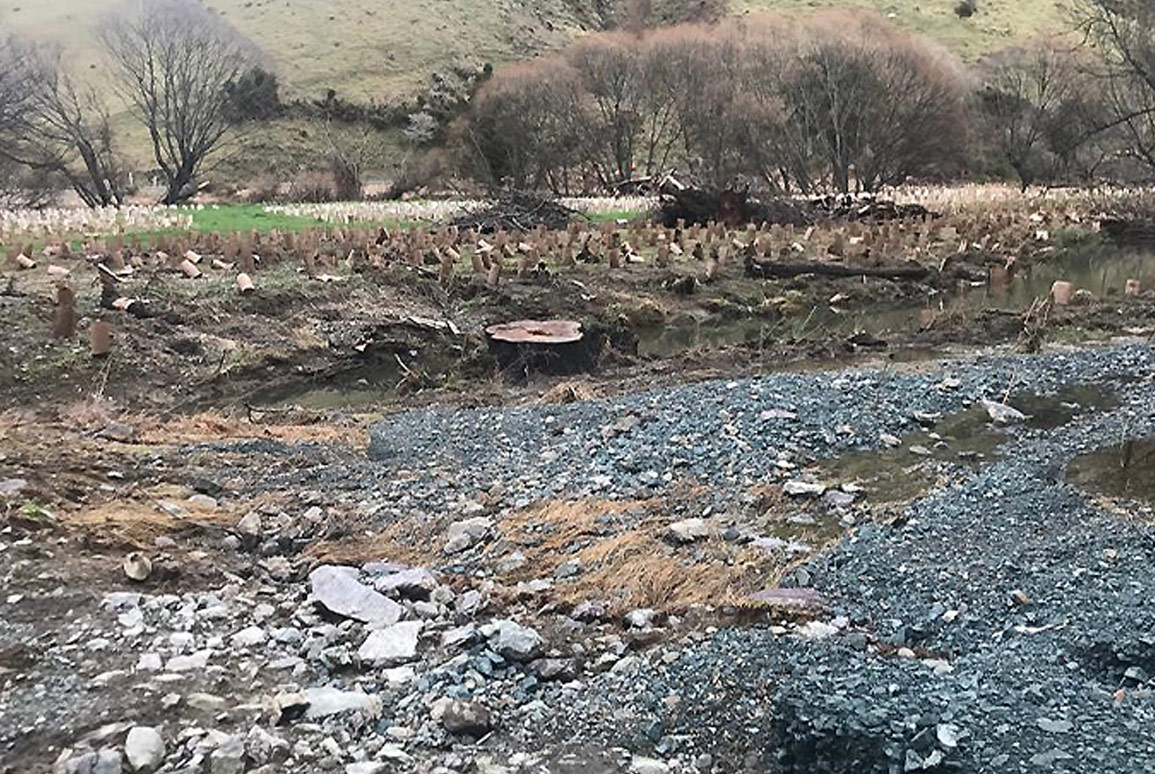Nature-based solutions: Erosion Control
27 March 2023
Landscape architect Liz Gavin is based in Boffa Miskell’s Nelson office and was impacted by the flooding of August 2022. She summarises key accepted nature-based solutions for soil retention and reducing sedimentation load in rivers through planting.

In August 2022 an atmospheric river impacted Nelson, bringing a week-long extreme weather event. While my own home was not damaged, 104 houses were ‘red-stickered’ at the peak of flooding, and our family property along the Wakapuaka River, where we had over 20,000 natives – either freshly planted or one year old – was inundated. The younger plants had their cardboard plant guards ripped off and bamboo stakes washed away. The older plants (one year old) suffered about a 10% mortality. Some plants resembled lollipops of trapped silt, leaves and sticks – and clearing that debris was highly labour-intensive. In some areas the riverbank was severely eroded. All of this set back our project “Wakapuaka Mouri” (run through MFE and Jobs for Nature) causing additional expense.
While this was a traumatic event to experience first-hand, it pales in the magnitude of the devastation of Cyclone Gabrielle recently experienced in Hawkes Bay. The impacts of these weather events on land and communities have renewed my interest in learning more about soil erosion control techniques and what can be done to reduce sedimentation at both a site and catchment scale.
After the Nelson weather event, the local Councils in Tasman and Nelson collaborated with NZ Landcare Trust to provide an information session for farmland and affected by slips and land erosion. As a landscape architect, it was a great way to reaffirm and learn about how planting can prevent or reduce soil erosion – in terms of gully erosion, bank erosion, landslides, and methods to “bank” silt to prevent or reduce sedimentation entering streams.
Planting methods can be broken down into the following nature-based planting solutions:
Afforestation
This involves densely planting a mixed variety of trees (natives and/or exotics) that, over time, bind their roots together to hold the soil (typically on a slope) and prevent or minimise landslides and earthflow. Afforestation can be used to stabilise gullies, with the underlying topography (gully size and slope) important in determining overall success. Gullies smaller than 1 hectare are more likely to be successfully stabilised compared to those greater, with little chance of success for gullies bigger than 10 hectares. Mature closed-canopy indigenous or exotic forest (and scrub) typically reduces sediment yield by 50-90% more than pasture catchments.
Reversion
Reversion is typically used on pastureland near waterways. Cows – and sheep (to a lesser extent) compact the soil and cause riparian banks to destabilise and break off into the river. Regularly removing stock to enable natural regeneration of grasses prevents both compaction and creates a riparian buffer that reduces soil erosion and trap sediment (depending on slope). Plant species suited to reversion will depend on the area, whether it is hill country, terraces, floodplains or riparian margins and should be chosen accordingly.
Spaced Planting
Erosion and earthflow can be reduced by planting trees at maximum 10m spacings. In some areas, this can reduce the chance of landslides by up to 95% when compared to paired pasture control sites. Landslide density is 80% less likely under indigenous forest, with mature forest and scrub (older than 10 years) performing better than new plantings. Exotic tree species such as willow (the non-invasive species) and gum can be used in place of natives. Pine Plantations are shallower rooted and while reducing slips, are not the most suited species. Those better suited have strong deep roots that perform better at holding the soil together. Planting at spacings greater than 10m has been found to reduce the effectiveness of landslide prevention.

Buffer Planting
Closely planted native grasses in areas adjacent to and within riparian margins reduce runoff velocity and can capture 40-100 percent of silt and sediment mass that enters them. This method works best on flat land, with the first 3-5 metres of planting most effective at capturing sediment. Grasses and flax grow quickly, have sufficient flexibility to bend over when covered by flood water, and recover once the waters have receded.
Plants suitable include:
- Ti kouka / Cabbage Tree / Cordyline australis
- Harakeke / flax / Phormium tenax
- Toe toe / Cortaderia spp
- Other grass and shrub species depending on which ones are endemic to the region in question.
Riparian Planting
Riparian planting occurs immediately adjacent to a watercourse and comprises deeply rooted trees and shrubs that hold the riverbanks together. This planting not only collects sediment but creates a topography that can slow flood waters down. It also widens the river channel, reducing erosion downstream. Some native floodplain species are best suited to do this work and can cope with inundation and sitting water – which can cause root rot. A range of root depths and above-ground vegetation provides soil stability and enhances filtration. Planting at spaces of one to one-and-a-half metres apart will create canopy and inhibit weed growth. Spraying prior to planting reduces weed competition, however this must be considered carefully in riparian areas to ensure poisons do not enter watercourses.
Knowledge of the site conditions is very important when compiling a revegetation list. The species below can be planted upfront (in first planting scheme) – with species checked to confirm local suitability. Other species need to be introduced in a second tranche, once established plants can provide protection from wind and frost. Species that can be planted in a revegetation programme include:
- Taupata / Coprosma repens;
- Karamu / Coprosma robusta;
- Ti kouka / Cabbage Tree (Cordyline australis);
- Korokio / Corokia cotoneaster;
- Ake ake / Dodonea viscosa
- Hebe sp.
- Kanuka / Kunzia ericoides
- Manuka / Leptospermum scoparium
- Mahoe / Melicytus ramiflorus
- Tarata / Pittosporum eugenouides (in fast drying areas away from standing water)
- Tōtara / Podocarpus tōtara
From my own experience in Nelson, Wineberry (Aristotelia serrata); and Lemonwood (Pittosporum eugenoides) were species that could not cope with standing water, however, are great on higher ground.
Wetland Planting
Wetlands – either constructed or re-vegetated natural areas that retain water; can be used to intercept suspended sediment before it reaches the main waterbody. The success of this strategy depends in part on the size of the wetland in comparison to the size of the catchment. Like riparian buffer areas, the plantings act as impediments and slow the flow of water – again, relative to the size of the wetland area.
Key Things to Consider
Understanding the site and underlying geology is essential when considering nature-based solutions for soil erosion control. It may be that planting methods should be paired with other engineering outcomes (that may also contain nature-based solutions) for the best results, depending on the complexity of the site and the catchment involved.
While site-level projects will help achieve localised improvement, consideration of ways to prevent soil erosion at a catchment scale will provide the most benefit. Boffa Miskell landscape architects and ecologists can design a planting palette and plan to suit the complexities of your site, and work with any other experts required for an effective solution.
For further information please contact Liz Gavin


